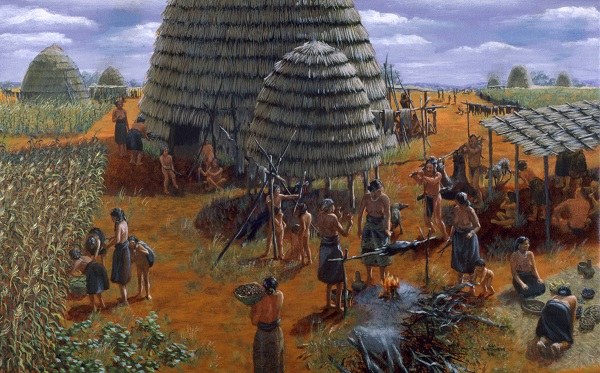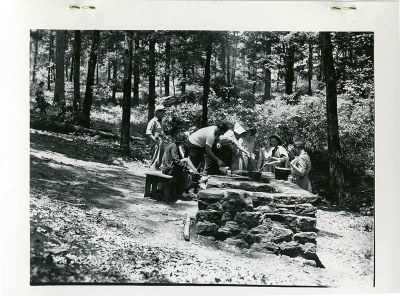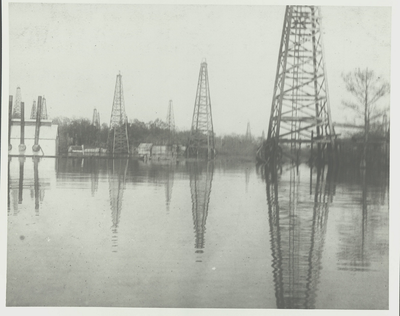History
Earliest Inhabitants
People have lived here for about 12,000 years. The earliest inhabitants hunted and gathered in the wetlands, forests and floodplains.
Newcomers and Old Enemies

- Traditional Caddoan village
Spanish explorers first arrived in Texas in 1542. French explorers arrived in 1685. Both groups encountered the Caddo on the Red River in the late 1600s. The Caddo successfully traded and negotiated with the newcomers.
The Caddo began to settle in the area near Caddo Lake around the 1800. They built ceremonial centers and maintained far-reaching trade routes. They hunted game with bows and arrows, fished, and farmed corn, beans and squash.
But conflict arose between the Spanish and French over Caddo territory. American settlement from the east and attacks from neighboring Native tribes led to increased loss of Caddo territory by the middle 1800s.
The United States government forcibly moved the Caddo to Oklahoma in 1859.
Logs and Legends
In 1691, Spanish explorer Domingo Teran de los Ríos encountered an impassible logjam on the Red River. The American Freemen-Custis Expedition was rerouted by the same “Great Raft” of fallen, partially submerged trees blocking the river in 1806.
The Great Raft consisted of uprooted trees piled in the river for over 80 miles. For centuries, spring flooding eroded riverbanks, toppled trees and increased logjams. The raft disrupted river flow and water spilled into Louisiana’s Cypress Valley, forming a lake around 1800.
That lake was named for the Caddoan people. According to one legend, a Caddo chief’s failure to obey the Great Spirit caused an earthquake that created Caddo Lake. Another tells of the formation of the lake and Sha'chahdínnih (Timber Hill), the last known Caddo village here.
Passage Through Caddo Lake
Explosive Solutions
Captain Henry Miller Shreve invented the first boat for removing snags, large trees entrenched in riverbeds. From 1832 to 1839, Shreve supervised the removal of the Great Raft with four snag boats and a crew of 150 men. By 1835, riverboats could navigate the Red River, Caddo Lake and Big Cypress Bayou.
However, floods continued, and new logjams formed. In 1871, the Army Corps of Engineers cleared snags with explosives and dredged the river to prevent future logjams.
Moneymaker Lake
With the Great Raft partially cleared in 1835, riverboat travel and commerce spurred economic growth in port towns from Jefferson on the Big Cypress Bayou down to New Orleans, LA.
Oil was discovered below Caddo Lake during the 1900s oil boom. The Gulf Refining Corporation dammed the lake to raise the water level to accommodate oil drilling equipment in 1914. The U.S. Army Corps of Engineers completed the current dam in Mooringsport, LA, in 1971.
Preserving Caddo Lake
Building a Park
Caddo Lake State Park opened on July 4, 1934.
Lady Bird Johnson’s father, T.J. Taylor, was one of several wealthy donors who gave private land for the park.
Civilian Conservation Corps (CCC)

- Photo courtesy of National Archives and Records Administration
Imagine yourself with little food, less money and no job during the Great Depression.
President Franklin D. Roosevelt created the Civilian Conservation Corps (CCC) in 1933 to provide jobs and job skills for young men to work on conservation projects. The program enrolled men from ages 17 to 25 who qualified for public assistance. They earned clothing, food, medical care and $30 a month; they sent much of the money to their families.
Historic features: CCC Park Structures
During the hot, humid summer of 1933, CCC Company 889 built the first structures, trails and firebreaks in the new park. Company 857 continued working from October 1934 to March 1937, building the park’s permanent structures. They converted 15 U.S. Army barracks and an Army mess hall into the nine rustic log cabins and group recreation hall we use today.
Your Place in History
As you paddle the bayous and swamps of Caddo Lake State Park or fish from peaceful piers, imagine boats that traversed these waters before you. Imagine those whose livelihood depended on fish from these waters.
As you hike among the hardwoods, listen for the ancient voices of the Caddo and early Texas settlers as they forged their lives in this land. Your stewardship helps protect and conserve their legacy.
As you dine beneath the pavilion or a picnic area, remember the labor of the men of the CCC whose work made this moment possible.
More information
- Interpretive Guide to Caddo Lake State Park (PDF)
- The Look of Nature: Caddo Lake State Park
- A New Deal for Texas State Parks (e-book resource for teachers and students)
- Mystery Object: Balopticon, Circa 1930

